Release Date : October 20, 2023
Developer(s) : Insomniac Games
Publisher(s) : Sony Interactive Entertainment
Platforms : PS5
Marvel’s Spider-Man 2 is finally getting some action from PlayStation Studios after a quiet year, marked only by the PS VR2 game Horizon Call of the Mountain. This new Spider-man game features both Peter Parker and Miles Morales ready to shake things up with their new suits. It must be said that the first game was a very pleasant open-world action-adventure, but had a hard time shaking off its image as an uninspired clone of Batman Arkham with Spidey.
The Miles expansion didn’t improve matters either, although it did have its fair share of quality features, and its launch price made people cringe. However, we were promised a lot, between two playable heroes, a New York almost doubled in size, and above all, two of the biggest threats in Spider-Man’s career, Venom and Kraven the Hunter. So now it’s time to see whether these new features manage to maintain our interest, or whether it’s time to move on to something else in this spoiler-free review of Marvel’s Spider-Man 2.
Peter & Miles: Greater Together

To be honest, the reunion with our heroes is a little strange. Officially, it’s been nine months since Miles Morales’ adventure (and almost two years since the first game), but it feels as if Peter is back just a few days after his confrontation with Doctor Octopus. With his life at a standstill, both personally and professionally, he’s waiting for something to happen.
Meanwhile, Miles has the opposite problem. He’s about to finish high school, so he has to start thinking about his future, which makes him very anxious. He takes advantage of Spider-Man to escape his responsibilities under his mentor’s caring yet worried eye, when he’s not busy with his best friend Harry Osborn, who’s miraculously recovered from his illness. Yes, you’ve guessed it, Insomniac continues to treat the characters behind their masks with care.
This pays off even more in an episode about the influence of the symbiote on Peter, and thus the weight his change can have on his relationships with Miles, MJ and the others. Fortunately, in case you were wondering, the writing is top-notch and Marvel’s Spider-Man 2 is a long, long way from the awkward Tobey McGuire in Sam Raimi’s third film.
What’s up Danger?

The emotional struggles of our two protagonists aren’t the only things that Marvel’s Spider-Man 2 has in store for us, obviously, as New York City is about to suffer the wrath of super-villains, with Kraven at the forefront. The hunter is looking for a prey that will do him honor, and so he arrives with an army of mercenaries to unleash enough chaos to flush out a predator worthy of the name.
And if that’s not enough, Venom is also part of the action, as are other Spider-Man enemies, but we’ll avoid saying too much to keep our promise of no spoilers, and also because we’re left a little hungry for more, given that this sequel is a little less generous with iconic villains to challenge. This makes sense, given that despite all there is to cover, the game retains the same lifespan as the first.
The main story takes between 15 and 20 hours to complete, and 100% of the game takes between 35 and 40 hours. All this is achieved by playing with both Peter and Miles, even if he takes a back seat in the plot, to make up for it in the additional content, which features him in several missions. It has to be said that the veteran Spider-Man needs more screen time for the symbiote arc to work.
Fortunately Better Than Spider-Man 3 and Venom
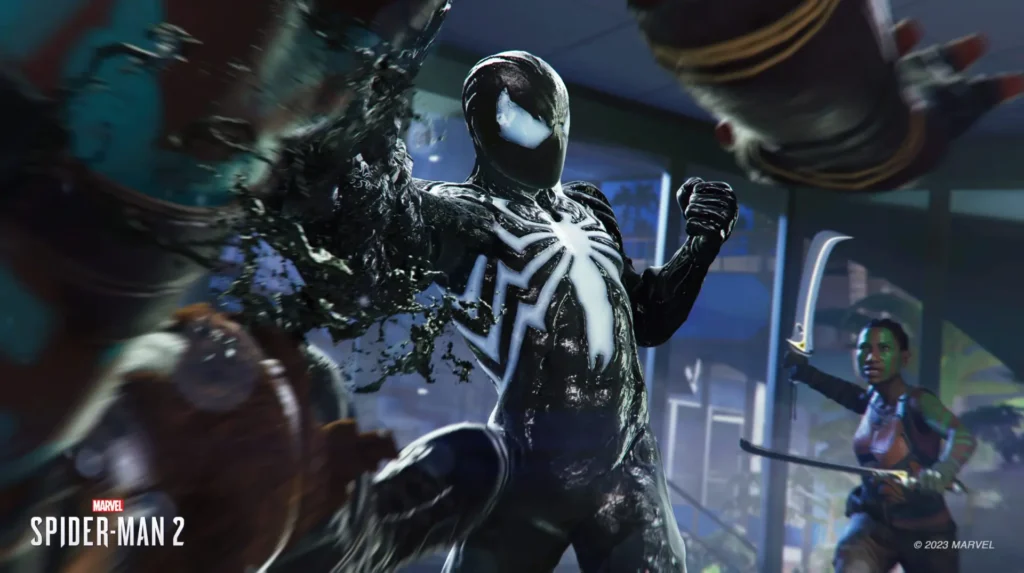
The result is a fast-paced adventure featuring several memorable action scenes, beginning with an opening scene rivaling those of the Kingpin and Rhino in previous adventures. Unfortunately, the weakness is Mary Jane again, or rather her infiltration scenes, which are back in a version that can be a little disappointing.
The strong point of the gameplay with MJ in the first game was that it allowed us to see another perspective of Spider-Man in action. Here, MJ is no longer a young lady in distress, as she’s just as capable of dealing damage to enemies as our heroes, even if it means going for the classic. But we’re happy to overlook these less interesting scenes in favor of her more important role in the story.

Marvel’s Spider-Man 2’s writers have done a good job of honoring mythical characters, arcs, and scenes, whether you’re a comic book fan or a more casual viewer of the various adaptations. Once again, they emphasize the whole emotional aspect in an attempt to counteract our knowledge of this mythology, which makes it harder to surprise us.
Doing Anything Except Pizza Delivery
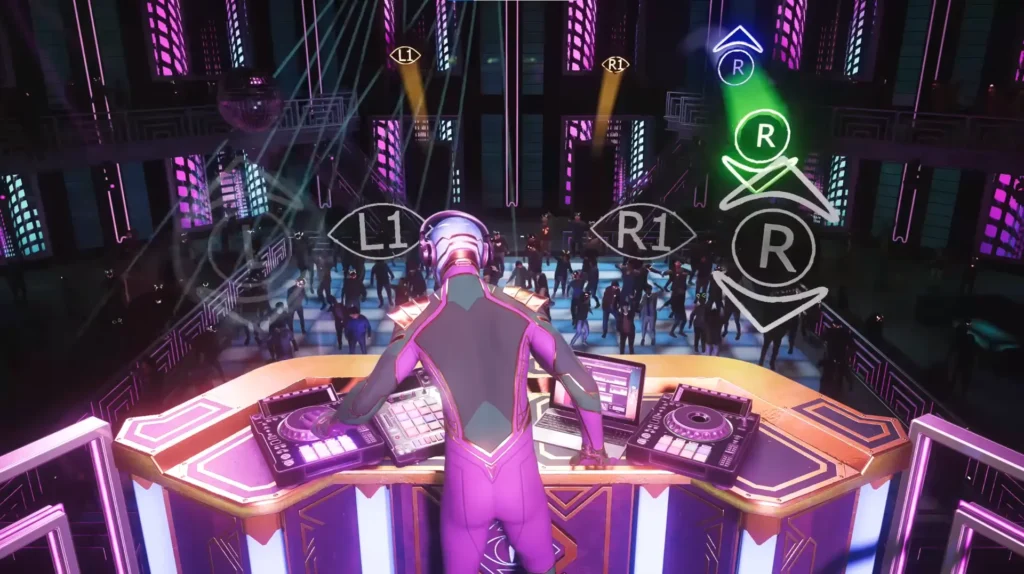
Throughout the adventure, Marvel’s Spider-Man 2 is generous enough to offer us different experiences via mini-games and such. Of course, Peter is still a scientist, and he still has to complete related tests, but rest assured that the types of puzzles have changed since the first game, in case the idea of finding them was already making you feel a little anxious.
You’ll be piloting drones and robots, playing rhythm games, cycling, basketball, tagging, and more. Insomniac likes to create little moments of their own, even when they’re optional. For example, if you visit an amusement park, you can go straight to the objective, or you can decide to try out each ride. The same goes for museums and other venues. It’s all about spending a little more time out of the suit.
The real downside is that almost everything in this game lasts a little too long in general. You’re in the middle of a mission, fighting waves of enemies, and by the time you start to wonder if it’s ever going to end, there are at least three more waves to go. This applies to these separate phases as well as to the main gameplay. Except for the best moments of courage, which seem to pass far too quickly.
The Clone Saga

Now it’s time to explain how the presence of two Spider-Men in the game actually works. No choices to be made, and no different campaigns, you switch from one to the other when you want or when a mission has a specific need, with a few handovers during certain action scenes. Peter and Miles share levels, upgrades, gadgets, and even a skill tree.
So the transition is smooth, and we’re not just talking about the absence of loading times. In fact, their gameplay is identical. Sure, Miles has electricity and Peter has both mechanical spider legs and a symbiote in this adventure, but all that only comes into play in their super-attacks. And even then, you’ll have to wait until you unlock new ones to find out that they don’t work exactly the same way (a forward leap that carries enemies away, a jump that carries enemies into the air…).
Each has his own skill tree to enhance these techniques, by adding electricity to Peter’s webs for example… Sure, this is to be expected given that we’ve played both before, but we’d have liked to see the difference between the two go further than the jokes they make while tapping their enemies. Since here, we’re switching mainly because we feel we’ve been with the same character a little too long.
No Wonder Even MJ scares Them…

You might have imagined, for example, that the sequences where you have to eliminate several enemies without being spotted would change greatly from one to the other, given that Miles can become invisible, but that’s not even the case. This is due to the addition of web lines that can be installed wherever you like, allowing you to eliminate enemies from any height. Some of you will say that we don’t have to use mechanics that break up the gameplay to such an extent.
But that’s without considering the AI, which seems even worse than before. Even without the ability to safely eliminate anything, enemies seem to do everything to get the drop on you, and never spot anything. You can set up your webs 2 meters above the ground, with enemies struggling to keep up with their allies, who will continue their patrols, bypassing them as if nothing happened.
These phases have lost much of their importance, and it’s clear that they weren’t Insomniac Games’ priority. They lose their strategic possibilities, with gadgets that are even less useful in these situations than before, and there are fewer of them. Except in the case of Kraven’s mercenary bases, which take advantage of their more limited presence to work on situations by forcing reconnaissance stages, for example.
Spider-Man’s Sekirolization
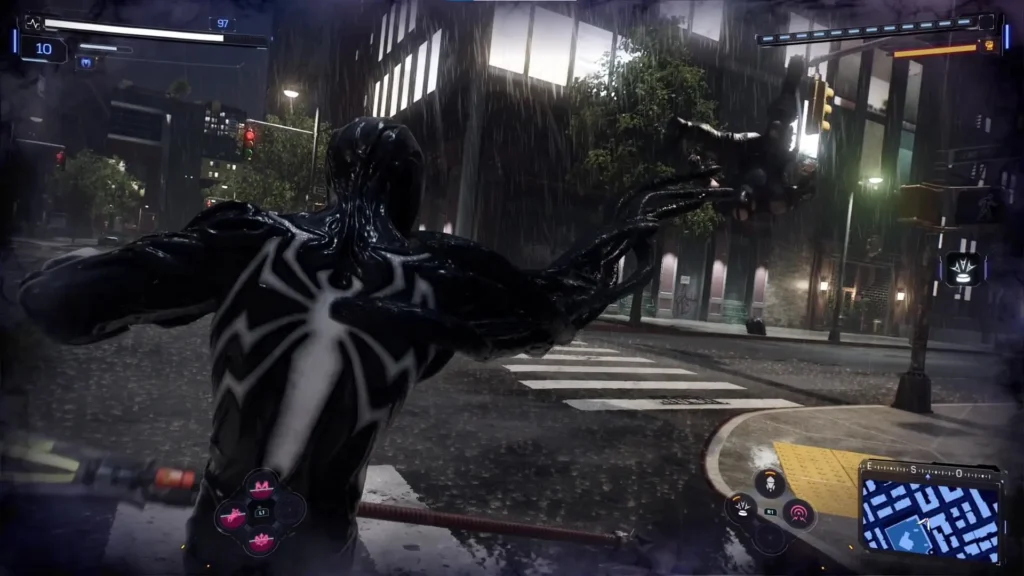
Marvel’s Spider-Man 2 is clearly all about combat. Battles are more nervous and spectacular, especially with the addition of parries. Like stealth, dodging has lost some of its importance in this episode. You can still take advantage of your spider sense to avoid blows, but why not counterattack directly?
By pressing the L1 button with the right timing, our heroes will actually block their opponents before pushing them back to gain the upper hand. It’s obviously more natural than being the eel. And between that, the special moves, ultimate attack, finishers, and other animations to underline the impact, our protagonists are clearly more powerful. Whether it’s Miles, who’s more confident, or Peter, who has new possibilities.
In fact, we must pay tribute to the excellent work done to convey the exhilarating side of the symbiote in combat, and why Peter can become addicted to it. He switches to berserker mode, the sound mix changes to make the outside world more distant, the screen darkens, vibrations intensify and special animations multiply. You’ll find yourself playing with your prey, temporarily forgetting the context, which is a real success, although all too rare.
We’ll Probably Be Able to Drive a Car in Spider-Man 3

Of course, Marvel’s Spider-Man 2 continues to excel in what was the great strength of the series: web-swinging. Instead of changing this aspect of the game too much, the developers decided to add the ability to glide thanks to the web wings which took us a while to adopt, not because of their quality, but rather because of the context.
Gliding is becoming so common in modern games that it’s bound to be less appealing in a game with another exciting method of movement. But then you come up against enough zones with nothing to hold on to that you end up incorporating the web wings, wind tunnels for acceleration, and columns of hot air for extra height in your routine.
Moving around is so fast and pleasant that we still refuse to use the fast travel feature. Which is quite impressive, considering the absence of loading and, above all, the little effect that transforms the map into a playable zone, giving the impression of being immersed in the action.
Please Turn off the Giant Holograms

The game does a good job of keeping these little scenes fresh. They’re more varied and can become more unpredictable, as another faction can jump in at any moment to complicate your mission. Or, on the contrary, the other Spidey may come to your aid and perform a few combos with you. We appreciate these rare team-ups, except when they prevent us from completing the optional objective.
Again, New York is packed with side activities, with enemy bases, collectibles, timed challenges, photos to take, scientific experiments and so on. It’s nothing revolutionary, but Marvel’s Spider-Man 2 has the good idea of limiting the number of events per activity, instead of asking us to do them five times per neighborhood, which is nice, as well as the absence of towers to synchronize.
Actually, the biggest problem is the visual overload. To make the experience more organic, activities are visible to the naked eye. Sometimes it’s subtle, like drones hovering over drone-related missions, sometimes it’s a giant holographic indicator that can’t be turned off. It’s so present that you never feel the need to use the Scan button, as everything is visible enough without it.
Dressed to Impress
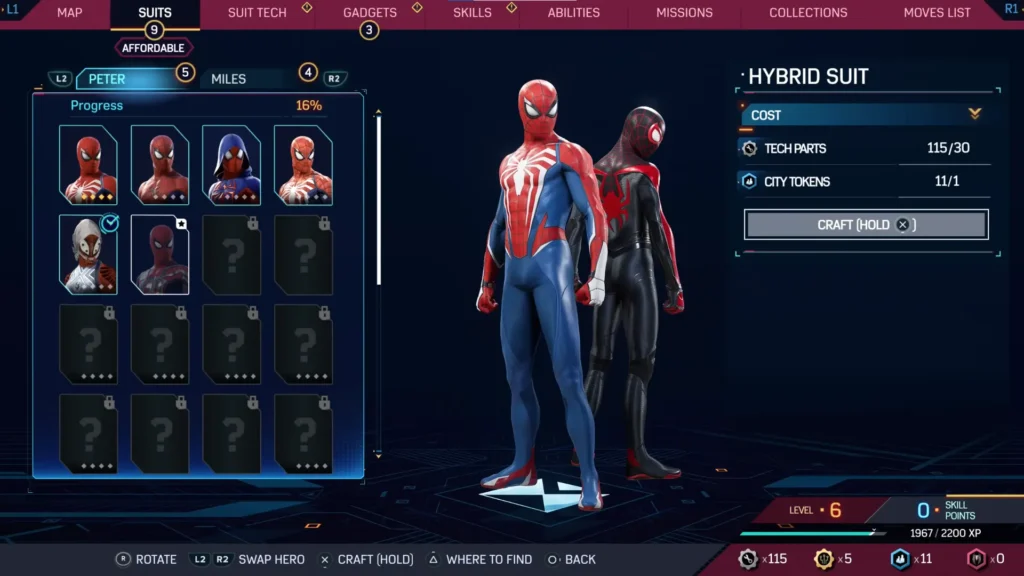
Clearly, the whole point of this additional content is to unlock new suits, mainly from previous games and film adaptations. Once again, the game is overflowing with love for the franchise, and the presence of the symbiote in Marvel’s Spider-Man 2 even allows Insomniac Games to offer several legendary black suits.
The other good news is that the suits are purely cosmetic, since the upgrades have been separated. Technically, you’re still upgrading your suit, it’s just that the change applies to all the outfits of both Spider-Men, so there’s no need to think about which outfit will give you what. You can enjoy yourself in this regard, and even the presence of the symbiote doesn’t prevent you from changing.
Another new feature of the suits is the presence of alternative colors. Costumes not taken from the films are now available in three variations. This is mostly a minor tweak, of course, because it’s a bit of a shame to give Peter’s colors to Miles and vice versa, but you never know if you’re particularly fond of one outfit and would like to see it on the other.
Marvel’s Spider-Man 2 Sees the Big Picture
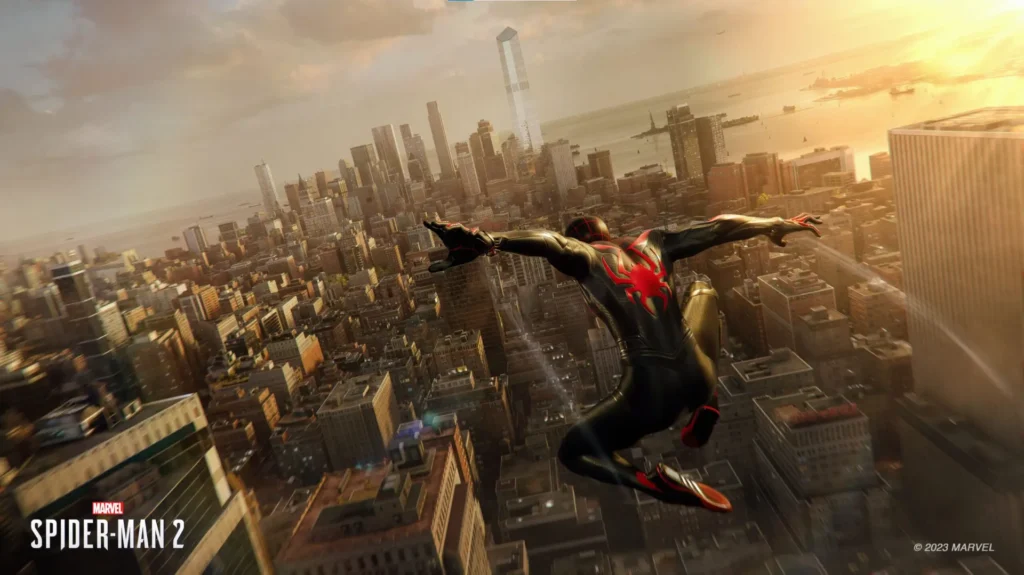
If you were afraid of playing in the same open world for the third time, rest assured that you won’t feel any repetition in Marvel’s Spider-Man 2, thanks to its careful selection of new neighborhoods on a double-sized map. You’ll find yourself heading for Queens and Brooklyn, which will take you back and forth over the East River. The absence of gigantic buildings certainly impacts the formula.
But what really stood out for us in this episode was the way the city evolved as the adventure progressed. Obviously, we’ll have to be vague if we don’t want to spoil too much, but when there’s a crisis, the signs are everywhere. Changes that demonstrate attention to detail and add a little more life to the overall picture. So does the attention paid to creating interiors and inhabitants behind each window.
Good work, which makes one detail even more irritating: the absence of a day-night cycle and dynamic weather. This doesn’t mean that time and weather don’t change, they just don’t evolve between missions. This is understandable when the storyline needs to be coherent, but the rest of the time, it’s just a shame not to see rain and/or night again. Especially when the end of the game locks us into a day of eternal good weather.
Framerate vs Fidelity

Technically speaking, Marvel’s Spider-Man 2 does a very good job, which will come as less of a surprise if you’ve played the Remaster of the first game and the Miles Morales expansion. The work done on Ratchet & Clank: Rift Apart seems to have paid off here, particularly in terms of taking advantage of the SSD, but also in terms of graphics optimization, with raytracing available on all settings.
There’s also the Performance mode, which aims for a constant 60 fps at the cost of less marked raytracing and a smaller number of displayed elements (people walking, cars in traffic, hair and body hair for the characters). We spent most of our sessions in this mode, and the graphics looked as great as they were, especially after the first update, with no FPS drops.
But if you’re looking for an eye-popping experience, there’s the Fidelity mode in 4K, which pushes everything to the max at the expense of 30 FPS, or even 40 if you’ve got a 120 Hz screen, and to make things even better, you can also activate VRR. Overall, the game runs smoothly and bugs are virtually non-existent, which is always a pleasure on such a big production, especially when you play it before its day one patch.
No, Eminem Doesn’t Sing Here

Let’s finish with the audio section: once again, the dubbing is top-notch, whether you’re Team VO with Yuri Lowenthal or VF with Donald Reignoux. We mention these actors above all to salute their performance on the different versions of Peter throughout the game, while managing to convince us of this evolution. We’d have liked a little more from J. Jonah Jameson, but the rest of the cast remains excellent.
The same goes for the composer John Paesano, who is once again in charge of the soundtrack and who also benefits from our attachment to the characters and their musical themes to deepen the experience. This also serves Earthgang and Benji as a sample for the Swing single that accompanies the game’s release, just as Jaden’s I’m Ready did for Miles Morales.
And it’s impossible to move on to the conclusion without a few words on an area that’s being taken more and more seriously, and that’s all for the good: the accessibility and comfort adjustment options. There are even more settings to adjust for a tailor-made experience, such as the deactivation of web-swinging aids. This aspect will continue to be worked on after release, notably with more context-setting for people with visual and hearing difficulties.
Conclusion
Marvel’s Spider-Man 2 is a solid game and a classic sequel. It improves existing features, seeks to eliminate weaknesses, and above all, offers more content. The problem comes from the fact that it comes after a game that was already too classic, and that another episode has already come along in the meantime. The lack of originality is once again compensated for by a good emotional treatment of the characters and the studio’s obvious love for this universe. The relationship between Peter and Miles holds up well, even if a little different gameplay would have been nice to enhance the experience of playing as both of them. But despite this lack of innovation, our attachment to the Spider-Family and the avenues opened up for the future mean that we can’t wait to head back to New York for further adventures, after a detour with The Wolverine.
